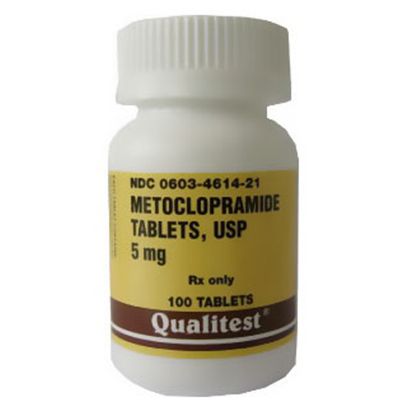SAVE 15% OFF 15% OFF Use Code EPX15 *

Metoclopramide for Dogs, Cats & Horses - 5mg (100 Tablets) (Manufacturer may vary) - [Gastrointestinal Health]
- Description
- Directions
- FAQ
- Reviews
Description
Metoclopramide is classified as an anti-emetic or anti-vomiting drug. Metoclopramide is prescribed to treat a wide variety of stomach issues that include vomiting, nausea, acid reflux disease, or food compaction. Metoclopramide blocks chemicals in the brain that cause your pet to vomit while stimulating the contraction of the stomach and intestines to help move food through the digestive tract.
Key Benefits
- Aids in the treatment of Gastric disorders in pets
- Treats cats with ileus
- Treats dogs with ileus
- Stimulates the mobility of the upper GI tract of cats and dogs
- Speeds gastric emptying
- Increases the sphincter pressure in the lower esophagus and reduces gastroesophageal reflux, which also may be helpful for decreasing vomiting.
How It Works
When motility (movement) in the stomach is reduced, food pools and creates a sensation of nausea and bloating. In some cases, bile refluxes from the intestine back into the stomach, causing irritation and more nausea. Metoclopramide normalizes stomach contractions so that food and bile can pass in the correct direction. Additionally, metoclopramide is able to cross a biochemical blood-brain barrier to control nausea. Metoclopramide helps the vomiting pet by acting directly on the brain to reduce the sensation of nausea.
Directions
Metoclopramide is usually given 3 or 4 times a day. Give each dose with plenty of water. Follow your veterinarian¿s instructions. If you do not understand the directions ask the pharmacist or veterinarian to explain them to you. Store metoclopramide at room temperature away from moisture and heat. Keep this medication away from children and pets.
- Metoclopramide is a prescription medication used to treat nausea, vomiting, and reflux disease in dogs and cats.
- Metoclopramide is also used to treat post-operative nausea and vomiting and to prevent nausea and vomiting associated with cancer chemotherapy.
Tip: Give each dose with plenty of water. Give exactly as directed by your veterinarian.
| Pet | Weight | Dosage |
|---|---|---|
| Dogs/Cats: | All weights | The usual dose is 0.1-0.2mg per pound of pet's body weight every 6-8 hours |
Cautions:
Do not use a monoamine oxidase inhibitor (MAOI) such as Anipryl, Selegiline, or a Preventic Flea Collar on your pet while giving this medication. Stop giving metoclopramide and contact your veterinarian immediately if your pet has an allergic reaction. Tell your veterinarian if your pet has kidney disease, diabetes, or high blood pressure, if your pet has had recent stomach surgery, or is pregnant or lactating.
Precautions:
Metoclopramide should not be used in animals with GI obstruction, perforation or hemorrhage. Metoclopramide should not be used in animals with a history of seizures, as it may lower the seizure threshold. Metoclopramide should not be used in animals with pheochromocytoma.
Possible Side Effects:
Dogs rarely experience CNS side-effects may include either sedation or hyperactivity. Cats may experience hyperactivity or disorientation.
Dogs and cats: Signs of neurotoxicity may occur in both dogs and cats at therapeutic levels. These signs usually will resolve within a few days of discontinuing the metoclopramide. Diphenhydramine may help reduce movement disorders, such as twisting movements of the face, neck, trunk or limbs, as well as CNS depression, nervousness, restlessness or frenzied behavior especially in cats. Constipation may occur in both species.
Possible Drug Interactions:
Metoclopramide may affect the absorption of other oral medications including cyclosporine and tetracyclines. Cholinergic drugs such as bethanechol may increase the effect of metoclopramide on the GI system. Metoclopramide may increase the CNS-depressant effects of phenothiazine tranquilizers, sedatives, narcotics, barbiturates, antihistamines and anesthetic agents. Extrapyramidal effects of metoclopramide also may be increased with concurrent use of phenothiazine tranquilizers, narcotics and butyrophenones. Acute hypotension may occur with IV use of metoclopramide and anesthetic drugs. Hypertension may occur with concurrent use of metoclopramide and MAO inhibitors. Opiate analgesics, atropine and other anticholinergic drugs may antagonize any effects on GI motility.
Storage:
Store at 20° to 25°C (68° to 77°F)


